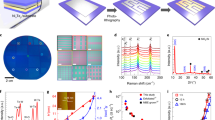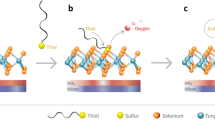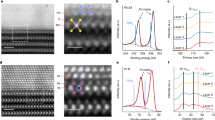Abstract
Heterostructures made using two-dimensional semiconducting transition metal dichalcogenides could be used to build next-generation electronic devices. However, their performance is limited by low-quality metal–semiconductor contacts, and it remains challenging to create contacts with variable work functions using metals or metallic transition metal dichalcogenides. Here we show that a one-step chemical vapour deposition method can be used to fabricate nanoplates of a two-dimensional metallic alloy VS2xSe2(1–x) (where 0 ≤ x ≤ 1), which has a continuously tunable band alignment. The work function of the alloy can vary from 4.79 ± 0.01 eV (VSe2, x = 0) to 4.64 ± 0.01 eV (VS2, x = 1.00). The van der Waals heterostructures of VS2xSe2(1–x) and p-type tungsten diselenide (WSe2) exhibit increased contact potential difference as x varies from 0 to 1, with transistors made using VSe2/WSe2 contacts showing a lower potential difference and better device performance than transistors with VSSe/WSe2 contacts, and in both cases, achieve better performance than devices with evaporated metal contacts. The contact potential difference in heterostructures of the alloy and n-type molybdenum disulfide can be turned from −71.5 mV (VSe2) to 0 mV (VSSe) to 59.3 mV (VS2)—that is, from Schottky to ohmic contacts—with the lowest-work-function (VS2) transistors showing the best performance.
This is a preview of subscription content, access via your institution
Access options
Access Nature and 54 other Nature Portfolio journals
Get Nature+, our best-value online-access subscription
$29.99 / 30 days
cancel any time
Subscribe to this journal
Receive 12 digital issues and online access to articles
$119.00 per year
only $9.92 per issue
Buy this article
- Purchase on Springer Link
- Instant access to full article PDF
Prices may be subject to local taxes which are calculated during checkout





Similar content being viewed by others
Data availability
Source data are provided with this paper. The other data that support the findings of this study are available from the corresponding authors upon reasonable request.
References
Wang, Q. H. et al. Electronics and optoelectronics of two-dimensional transition metal dichalcogenides. Nat. Nanotechnol. 7, 699–712 (2012).
Chhowalla, M. et al. The chemistry of two-dimensional layered transition metal dichalcogenide nanosheets. Nat. Chem. 5, 263–275 (2013).
Duan, X., Wang, C., Pan, A., Yu, R. & Duan, X. Two-dimensional transition metal dichalcogenides as atomically thin semiconductors: opportunities and challenges. Chem. Soc. Rev. 44, 8859–8876 (2015).
Dai, M. et al. Ultrafast and sensitive self-powered photodetector featuring self-limited depletion region and fully depleted channel with van der Waals contacts. ACS Nano 14, 9098–9106 (2020).
Ma, H. et al. Controlled synthesis of ultrathin PtSe2 nanosheets with thickness-tunable electrical and magnetoelectrical properties. Adv. Sci. 9, 2103507 (2022).
Manzeli, S., Ovchinnikov, D., Pasquier, D., Yazyev, O. V. & Kis, A. 2D transition metal dichalcogenides. Nat. Rev. Mater. 2, 17033 (2017).
Zhang, Z. et al. Endoepitaxial growth of monolayer mosaic heterostructures. Nat. Nanotechnol. 17, 493–499 (2022).
Li, H. et al. Lateral growth of composition graded atomic layer MoS2(1–x)Se(2x) nanosheets. J. Am. Chem. Soc. 137, 5284–5287 (2015).
Li, H. et al. Composition-modulated two-dimensional semiconductor lateral heterostructures via layer-selected atomic substitution. ACS. Nano 11, 961–967 (2017).
Duan, X. et al. Synthesis of WS2xSe2–2x alloy nanosheets with composition-tunable electronic properties. Nano Lett. 16, 264–269 (2016).
Wang, Q. et al. Wafer-scale highly oriented monolayer MoS2 with large domain sizes. Nano Lett. 20, 7193–7199 (2020).
Choi, M. S. et al. Recent progress in 1D contacts for 2D-material-based devices. Adv. Mater. 34, 2202408 (2022).
Chen, P. et al. Approaching the intrinsic exciton physics limit in two-dimensional semiconductor diodes. Nature 599, 404–410 (2021).
Li, W. et al. Realization of ultra-scaled MoS2 vertical diodes via double-side electrodes lamination. Nano Lett. 22, 4429–4436 (2022).
Zhao, B. et al. 2D metallic transition metal dichalcogenides: structures, synthesis, properties, and applications. Adv. Funct. Mater. 31, 2105132 (2021).
Liu, Y. et al. Promises and prospects of two-dimensional transistors. Nature 591, 43–53 (2021).
Liu, Y. et al. Approaching the Schottky-Mott limit in van der Waals metal-semiconductor junctions. Nature 557, 696–700 (2018).
Wang, Y. et al. Van der Waals contacts between three-dimensional metals and two-dimensional semiconductors. Nature 568, 70–74 (2019).
Wang, Y. et al. P-type electrical contacts for two-dimensional transition metal dichalcogenides. Nature 610, 61–66 (2022).
Shen, P. C. et al. Ultralow contact resistance between semimetal and monolayer semiconductors. Nature 593, 211–217 (2021).
Li, J. et al. Controllable preparation of 2D vertical van der Waals heterostructures and superlattices for functional applications. Small 18, 2107059 (2022).
Song, S. et al. Wafer-scale production of patterned transition metal ditelluride layers for two-dimensional metal-semiconductor contacts at the Schottky-Mott limit. Nat. Electron. 3, 207–215 (2020).
Zhang, X. et al. Near-ideal van der Waals rectifiers based on all-two-dimensional Schottky junctions. Nat. Commun. 12, 1522 (2021).
Shi, J. et al. Two-dimensional metallic vanadium ditelluride as a high-performance electrode material. ACS Nano 15, 1858–1868 (2021).
Leong, W. S. et al. Synthetic lateral metal-semiconductor heterostructures of transition metal disulfides. J. Am. Chem. Soc. 140, 12354–12358 (2018).
Zhang, Z. et al. Van der Waals epitaxial growth of 2D metallic vanadium diselenide single crystals and their extra-high electrical conductivity. Adv. Mater. 29, 1702359 (2017).
Li, J. et al. Synthesis of ultrathin metallic MTe2 (M = V, Nb, Ta) single-crystalline nanoplates. Adv. Mater. 30, 1801043 (2018).
Ma, H. et al. Thickness-tunable synthesis of ultrathin type-II Dirac semimetal PtTe2 single crystals and their thickness-dependent electronic properties. Nano Lett. 18, 3523–3529 (2018).
Ma, H. et al. Chemical vapor deposition growth of single crystalline CoTe2 nanosheets with tunable thickness and electronic properties. Chem. Mater. 30, 8891–8896 (2018).
Zhao, B. et al. Synthetic control of two-dimensional NiTe2 single crystals with highly uniform thickness distributions. J. Am. Chem. Soc. 140, 14217–14223 (2018).
Wu, R. et al. Van der Waals epitaxial growth of atomically thin 2D metals on dangling‐bond‐free WSe2 and WS2. Adv. Funct. Mater. 29, 1806611 (2019).
Zhao, B. et al. Van der Waals epitaxial growth of ultrathin metallic NiSe nanosheets on WSe2 as high performance contacts for WSe2 transistors. Nano Res. 12, 1683–1689 (2019).
Li, W. et al. Synthesis of 2D α‐GeTe single crystals and α-GeTe/WSe2 heterostructures with enhanced electronic performance. Adv. Funct. Mater. 32, 2201673 (2022).
Li, J. et al. General synthesis of two-dimensional van der Waals heterostructure arrays. Nature 579, 368–374 (2020).
Wu, R. et al. Bilayer tungsten diselenide transistors with on-state currents exceeding 1.5 milliamperes per micrometre. Nat. Electron. 5, 497–504 (2022).
Liu, Y. Y., Stradins, P. & Wei, S. H. Van der Waals metal-semiconductor junction: weak Fermi level pinning enables effective tuning of Schottky barrier. Sci. Adv. 2, 1600069 (2016).
Thomson, G. W. The Antoine equation for vapor-pressure data. Chem. Rev. 38, 1–39 (1946).
Ji, Q. et al. Metallic vanadium disulfide nanosheets as a platform material for multifunctional electrode applications. Nano Lett. 17, 4908–4916 (2017).
Epp, J. X-ray diffraction (XRD) techniques for materials characterization. In Materials Characterization Using Nondestructive Evaluation (NDE) Methods 81–124 (Elsevier, 2016).
Matović, B. et al. Synthesis and characterization of nanocrystaline hexagonal boron nitride powders: XRD and luminescence properties. Ceram. Int. 42, 16655–16658 (2016).
Guo, H. et al. Ternary MoSe2xTe2–2x alloy with tunable band gap for electronic and optoelectronic transistors. Nanotechnology 31, 345704 (2020).
Liu, Z. et al. Epitaxially grown monolayer VSe2: an air-stable magnetic two-dimensional material with low work function at edges. Sci. Bull. 63, 419–425 (2018).
Hu, P. et al. Agent-assisted VSSe ternary alloy single crystals as an efficient stable electrocatalyst for the hydrogen evolution reaction. J. Mater. Chem. A 7, 15714–15721 (2019).
Suh, J. et al. Doping against the native propensity of MoS2: degenerate hole doping by cation substitution. Nano Lett. 14, 6976–6982 (2014).
Yao, W. et al. Synthesis of 2D MoS2(1−x)Se2x semiconductor alloy by chemical vapor deposition. RSC Adv. 10, 42172–42177 (2020).
Cui, F. et al. Synthesis of large-size 1T’ ReS2xSe2(1–x) alloy monolayer with tunable bandgap and carrier type. Adv. Mater. 29, 1705015 (2017).
Matoba, M., Anzai, S. & Fujimori, A. Thermal expansion, thermoelectric power, and XPS study of the nonmetal-metal transition in Ni1–xS1–ySey. J. Phys. Soc. Jpn. 60, 4230–4244 (1991).
Kumar, S. et al. Synergic effect of vanadium trichloride on the reversible hydrogen storage performance of the Mg MgH2 system. Int. J. Hydrog. Energy 43, 15330–15337 (2018).
Li, Y., Xu, C. Y. & Zhen, L. Surface potential and interlayer screening effects of few-layer MoS2 nanoflakes. App. Phy. Lett. 102, 143110 (2013).
Wang, X. et al. Direct synthesis and enhanced rectification of alloy-to-alloy 2D type-II MoS2(1–x)Se2x/SnS2(1–y)Se2y heterostructures. Adv. Mater. 33, 2006908 (2021).
Zhang, Z. et al. Epitaxial growth of two-dimensional metal-semiconductor transition-metal dichalcogenide vertical stacks (VSe2/MX2) and their band alignments. ACS Nano 13, 885–893 (2019).
Acknowledgements
We acknowledge support from the National Key R&D Program of the Ministry of Science and Technology of China (grant no. 2022YFA1203801 to X.D.); the National Natural Science Foundation of China (grant nos. 51991340, 51991343, 52221001 and 52102168 to X.D. and J.L.); the Hunan Key R&D Program Project (grant no. 2022GK2005 to X.D.); the Natural Science Foundation of Hunan Province (grant no. 2023JJ20009 to J.L.); the Ningbo Natural Science Foundation (grant no. 2023J023 to X.Y.); and the Natural Science Foundation of Chongqing, China (grant no. cstc2021jcyj-msxmX0321 to J.L.). The funders had no role in the study design, data collection and analysis, decision to publish or preparation of the manuscript.
Author information
Authors and Affiliations
Contributions
X.D. and J. Li conceived the research and designed the experiments. X.L. developed a method to grow VS2xSe2(1–x) alloy nanoplates and their heterostructures and fabricated and measured all the devices. H.L. performed the KPFM study. J.Z. performed the DFT calculations. F.D., R.S., W.H., J. Liang and W.L. participated in the material growth. Zucheng Zhang, J.L., X.Y. and R.W. participated in the device fabrication. Y.L., B.L., B.Z., J. Liu, Z.W. and Zhengwei Zhang contributed to the discussion and data analysis. X.L., J. Li and X.D. co-wrote the manuscript with input from all the authors. All authors discussed the results and commented on the manuscript.
Corresponding authors
Ethics declarations
Competing interests
The authors declare no competing interests.
Peer review
Peer review information
Nature Electronics thanks Hui Pan and the other anonymous reviewer(s) for their contribution to the peer review of this work.
Additional information
Publisher’s note Springer Nature remains neutral with regard to jurisdictional claims in published maps and institutional affiliations.
Supplementary information
Supplementary Information
Supplementary Figs. 1–16, Table 1 and Notes.
Source data
Source Data Fig. 1
Statistical source data for Fig. 1.
Source Data Fig. 2
Statistical source data for Fig. 2.
Source Data Fig. 3
Statistical source data for Fig. 3.
Source Data Fig. 4
Statistical source data for Fig. 4.
Source Data Fig. 5
Statistical source data for Fig. 5.
Rights and permissions
Springer Nature or its licensor (e.g. a society or other partner) holds exclusive rights to this article under a publishing agreement with the author(s) or other rightsholder(s); author self-archiving of the accepted manuscript version of this article is solely governed by the terms of such publishing agreement and applicable law.
About this article
Cite this article
Li, X., Long, H., Zhong, J. et al. Two-dimensional metallic alloy contacts with composition-tunable work functions. Nat Electron 6, 842–851 (2023). https://doi.org/10.1038/s41928-023-01050-7
Received:
Accepted:
Published:
Issue Date:
DOI: https://doi.org/10.1038/s41928-023-01050-7
This article is cited by
-
A work-function-tunable 2D alloy for electrical contacts
Nature Electronics (2023)



